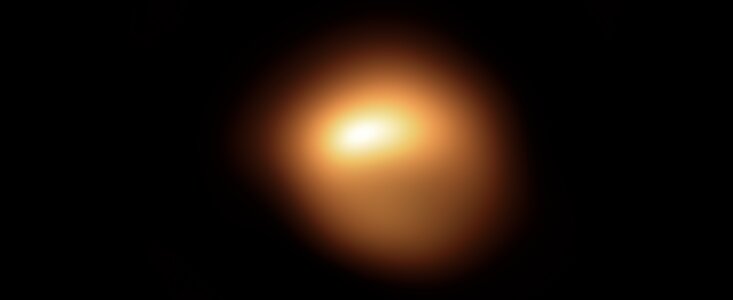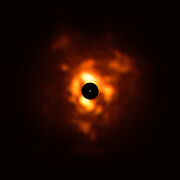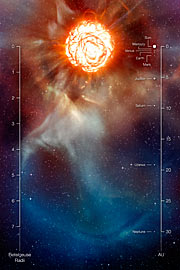Persbericht
ESO-telescoop bekijkt het oppervlak van zwakke Betelgeuze
14 februari 2020
Met behulp van ESO’s Very Large Telescope (VLT) hebben astronomen het unieke afzwakken van Betelgeuze, een rode superreuzenster in het sterrenbeeld Orion, vastgelegd. De prachtige nieuwe opnamen van het oppervlak van de ster laten zien dat de rode superreus niet alleen minder licht geeft, maar ook van vorm lijkt te veranderen.
Betelgeuze is een opvallend lichtbaken aan de nachthemel, maar eind vorig jaar begon hij af te zwakken. Op het moment van schrijven heeft Betelgeuze nog ongeveer 36 procent van zijn normale helderheid – een verandering die zelfs met het blote oog opvalt. Astronomie-fans en wetenschappers willen maar al te graag het fijne van dit ongekende gedrag weten.
Een team onder leiding van Miguel Montargès, astronoom aan de KU Leuven, heeft de ster sinds december waargenomen met ESO’s Very Large Telescope, om erachter te komen waarom diens helderheid afneemt. Een van de eerste resultaten van deze nieuwe campagne is een prachtige nieuwe opname van het oppervlak van Betelgeuze, die eind vorig jaar is gemaakt met het SPHERE-instrument.
Toevallig had het team de ster ook in januari 2019 al met SPHERE waargenomen, voordat deze zwakker werd, wat een voor-en-na-beeld van Betelgeuze heeft opgeleverd. De opnamen, gemaakt in zichtbaar licht, laten goed zien welke veranderingen in helderheid en in schijnbare vorm de ster ondergaat.
Veel astronomie-fans vroegen zich af of het zwakker worden van Betelgeuze een voorbode van een explosie was. Net als alle rode superreuzen zal Betelgeuze ooit een supernova-explosie ondergaan. Maar astronomen denken niet dat het nu al zo ver is. Zij hebben andere theorieën die kunnen verklaren wat de veranderingen in vorm en helderheid op de SPHERE-beelden nu precies veroorzaakt. ‘De twee scenario’s waaraan we werken is dat het oppervlak afkoelt ten gevolge van ongewone stellaire activiteit of dat de ster stof onze kant op blaast’, zegt Montargès [1]. ‘Natuurlijk is het wel zo dat onze kennis van rode superreuzen onvolledig is, en we nog middenin in het onderzoek zitten, dus er kan ons nog best een verrassing te wachten staan.’
Voor hun onderzoek van deze ster, die meer dan 700 lichtjaar van ons verwijderd is, hadden Montargès en zijn team de VLT op Cerro Paranal in Chili nodig. ‘ESO’s Paranal-sterrenwacht is een van de weinige faciliteiten die in staat is om het oppervlak van Betelgeuze in beeld te brengen’, zegt hij. De instrumenten van ESO’s VLT zijn in staat om waarnemingen te doen van zichtbaar licht tot het mid-infrarood. Hierdoor kunnen astronomen zowel het oppervlak van Betelgeuze zien als het materiaal rond de ster. ‘Dit is de enige manier waarop we kunnen begrijpen wat er met de ster gebeurt.’
Een andere nieuwe opname, verkregen met het VISIR-instrument van de VLT, toont het infrarode licht dat in december 2019 door het stof rond Betelgeuze werd uitgezonden. Deze waarnemingen zijn gedaan door een team onder leiding van Pierre Kervella van de Sterrenwacht van Parijs, die uitlegt dat de golflengte van de opname vergelijkbaar is met die van warmtecamera’s. De stofwolken, die op de VISIR-opname op vlammen lijken, ontstaan wanneer de ster materiaal de ruimte in blaast.
‘In populair-astronomische context kom je vaak de uitdrukking ‘we bestaan uit sterrenstof’ tegen. Maar waar komt dit stof eigenlijk vandaan?’, zegt Emili Cannon, promovendus aan de KU Leuven die met SPHERE-opnamen van rode superreuzen werkt. ‘In de loop van hun bestaan stoten rode superreuzen zoals Betelgeuze, al voordat ze als supernovae exploderen, grote hoeveelheden stof uit. Moderne technologie stelt ons in staat om deze objecten, honderden lichtjaren hiervandaan, ongekend gedetailleerd te bestuderen, wat ons de kans geeft om het raadsel van hun massaverlies te ontrafelen.’
Noten
[1] Het ongelijkmatige oppervlak van Betelgeuze bestaat uit reusachtige convectiecellen die bewegen, krimpen en opzwellen. Daarnaast pulseert de ster ook als een kloppend hart, waardoor hij periodiek van helderheid verandert. Met ‘stellaire activiteit’ worden deze veranderingen in convectie en pulsatie in Betelgeuze bedoeld.
Meer informatie
Meer informatie
Het onderzoeksteam bestaat uit Miguel Montargès (Instituut voor Sterrenkunde, KU Leuven), Emily Cannon (Instituut voor Sterrenkunde, KU Leuven), Pierre Kervella (LESIA, Sterrenwacht van Parijs – PSL, Frankrijk), Eric Lagadec (Laboratoire Lagrange, Sterrenwacht van de Côte d'Azur, Frankrijk), Faustine Cantalloube (Max-Planck-Institut für Astronomie, Heidelberg, Duitsland), Joel Sánchez Bermúdez (Instituto de Astronomía, Universidad Nacional Autónoma de México, Mexico City, Mexico en Max-Planck-Institut für Astronomie, Heidelberg, Duitsland), Andrea Dupree (Center for Astrophysics | Harvard & Smithsonian, VS), Elsa Huby (LESIA, Observatoire de Paris – PSL, Frankrijk), Ryan Norris (Georgia State University, VS), Benjamin Tessore (IPAG, Frankrijk), Andrea Chiavassa (Laboratoire Lagrange, Sterrenwacht van de Côte d'Azur, Frankrijk), Claudia Paladini (ESO, Chili), Agnès Lèbre (Universiteit van Montpellier, Frankrijk), Leen Decin (Instituut voor Sterrenkunde, KU Leuven), Markus Wittkowski (ESO, Duitsland), Gioia Rau (NASA/GSFC, VS), Arturo López Ariste (IRAP, Frankrijk), Stephen Ridgway (NSF’s National Optical-Infrared Astronomy Research Laboratory, VS), Guy Perrin (LESIA, Observatoire de Paris – PSL, Frankrijk), Alex de Koter (Anton Pannekoek Instituut voor Sterrenkunde, Universiteit van Amsterdam & Instituut voor Sterrenkunde, KU Leuven), Xavier Haubois (ESO, Chili).
ESO is de belangrijkste intergouvernementele astronomische organisatie in Europa en verreweg de meest productieve sterrenwacht ter wereld. Zij wordt ondersteund door zestien lidstaten: België, Denemarken, Duitsland, Finland, Frankrijk, Ierland, Italië, Nederland, Oostenrijk, Polen, Portugal, Spanje, Tsjechië, het Verenigd Koninkrijk, Zweden en Zwitserland, en door gastland Chili, met Australië als strategische partner. ESO voert een ambitieus programma uit, gericht op het ontwerpen, bouwen en beheren van grote sterrenwachten die astronomen in staat stellen om belangrijke wetenschappelijke ontdekkingen te doen. Ook speelt ESO een leidende rol bij het bevorderen en organiseren van samenwerking op astronomisch gebied. ESO beheert drie waarnemingslocaties van wereldklasse in Chili: La Silla, Paranal en Chajnantor. Op Paranal staan ESO’s Very Large Telescope (VLT) en haar toonaangevende Very Large Telescope Interferometer, evenals twee surveytelescopen – VISTA, die in het infrarood werkt, en de op zichtbare golflengten opererende VLT Survey Telescope. Ook op Paranal zal ESO onderkomen bieden aan en het beheer voeren over de Cherenkov Telescope Array South, ’s werelds grootste en meest gevoelige observatorium van gammastraling. ESO speelt tevens een belangrijke partnerrol bij twee faciliteiten op Chajnantor, APEX en ALMA, het grootste astronomische project van dit moment. En op Cerro Armazones, nabij Paranal, bouwt ESO de 39-meter Extremely Large Telescope, de ELT, die ‘het grootste oog op de hemel’ ter wereld zal worden.
Links
Contact
Miguel Montargès
FWO [PEGASUS]² Marie Skłodowska-Curie Fellow / Institute of Astronomy, KU Leuven
Leuven, Belgium
Tel: +32 16 32 74 67
E-mail: miguel.montarges@kuleuven.be
Emily Cannon
Institute of Astronomy, KU Leuven
Leuven, Belgium
Tel: +32 16 32 88 92
E-mail: emily.cannon@kuleuven.be
Pierre Kervella
LESIA, Observatoire de Paris - PSL
Paris, France
Tel: +33 0145077966
E-mail: pierre.kervella@observatoiredeparis.psl.eu
Bárbara Ferreira
ESO Public Information Officer
Garching bei München, Germany
Tel: +49 89 3200 6670
Mob: +49 151 241 664 00
E-mail: pio@eso.org
Rodrigo Alvarez (press contact België)
ESO Science Outreach Network
en Planetarium, Royal Observatory of Belgium
Tel: +32-2-474 70 50
E-mail: eson-belgië@eso.org
Over dit bericht
| Persberichten nr.: | eso2003nl-be |
| Naam: | Betelgeuse |
| Type: | Milky Way : Star : Evolutionary Stage : Red Supergiant |
| Facility: | Very Large Telescope |
| Instruments: | SPHERE, VISIR |
Our use of Cookies
We use cookies that are essential for accessing our websites and using our services. We also use cookies to analyse, measure and improve our websites’ performance, to enable content sharing via social media and to display media content hosted on third-party platforms.
ESO Cookies Policy
The European Organisation for Astronomical Research in the Southern Hemisphere (ESO) is the pre-eminent intergovernmental science and technology organisation in astronomy. It carries out an ambitious programme focused on the design, construction and operation of powerful ground-based observing facilities for astronomy.
This Cookies Policy is intended to provide clarity by outlining the cookies used on the ESO public websites, their functions, the options you have for controlling them, and the ways you can contact us for additional details.
What are cookies?
Cookies are small pieces of data stored on your device by websites you visit. They serve various purposes, such as remembering login credentials and preferences and enhance your browsing experience.
Categories of cookies we use
Essential cookies (always active): These cookies are strictly necessary for the proper functioning of our website. Without these cookies, the website cannot operate correctly, and certain services, such as logging in or accessing secure areas, may not be available; because they are essential for the website’s operation, they cannot be disabled.
Functional Cookies: These cookies enhance your browsing experience by enabling additional features and personalization, such as remembering your preferences and settings. While not strictly necessary for the website to function, they improve usability and convenience; these cookies are only placed if you provide your consent.
Analytics cookies: These cookies collect information about how visitors interact with our website, such as which pages are visited most often and how users navigate the site. This data helps us improve website performance, optimize content, and enhance the user experience; these cookies are only placed if you provide your consent. We use the following analytics cookies.
Matomo Cookies:
This website uses Matomo (formerly Piwik), an open source software which enables the statistical analysis of website visits. Matomo uses cookies (text files) which are saved on your computer and which allow us to analyze how you use our website. The website user information generated by the cookies will only be saved on the servers of our IT Department. We use this information to analyze www.eso.org visits and to prepare reports on website activities. These data will not be disclosed to third parties.
On behalf of ESO, Matomo will use this information for the purpose of evaluating your use of the website, compiling reports on website activity and providing other services relating to website activity and internet usage.
Matomo cookies settings:
Additional Third-party cookies on ESO websites: some of our pages display content from external providers, e.g. YouTube.
Such third-party services are outside of ESO control and may, at any time, change their terms of service, use of cookies, etc.
YouTube: Some videos on the ESO website are embedded from ESO’s official YouTube channel. We have enabled YouTube’s privacy-enhanced mode, meaning that no cookies are set unless the user actively clicks on the video to play it. Additionally, in this mode, YouTube does not store any personally identifiable cookie data for embedded video playbacks. For more details, please refer to YouTube’s embedding videos information page.
Cookies can also be classified based on the following elements.
Regarding the domain, there are:
- First-party cookies, set by the website you are currently visiting. They are stored by the same domain that you are browsing and are used to enhance your experience on that site;
- Third-party cookies, set by a domain other than the one you are currently visiting.
As for their duration, cookies can be:
- Browser-session cookies, which are deleted when the user closes the browser;
- Stored cookies, which stay on the user's device for a predetermined period of time.
How to manage cookies
Cookie settings: You can modify your cookie choices for the ESO webpages at any time by clicking on the link Cookie settings at the bottom of any page.
In your browser: If you wish to delete cookies or instruct your browser to delete or block cookies by default, please visit the help pages of your browser:
Please be aware that if you delete or decline cookies, certain functionalities of our website may be not be available and your browsing experience may be affected.
You can set most browsers to prevent any cookies being placed on your device, but you may then have to manually adjust some preferences every time you visit a site/page. And some services and functionalities may not work properly at all (e.g. profile logging-in, shop check out).
Updates to the ESO Cookies Policy
The ESO Cookies Policy may be subject to future updates, which will be made available on this page.
Additional information
For any queries related to cookies, please contact: pdprATesoDOTorg.
As ESO public webpages are managed by our Department of Communication, your questions will be dealt with the support of the said Department.










